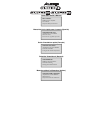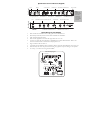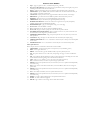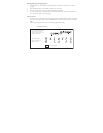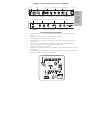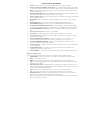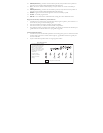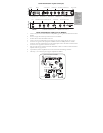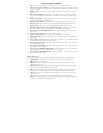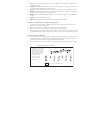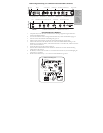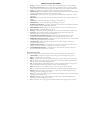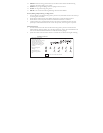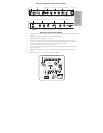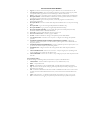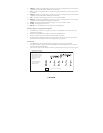Features of the Wildfire
1. Input – plug your guitar into this 1/4" unbalanced input using a TS cable.
2. Program Up/Down Buttons – these change the program number; when pressed together, they put the
unit in Bypass and Mute modes and access the tuner.
3. Display – indicates bank and program, shows parameter values and displays pitch in tuner mode.
4. EFFECT Knob – puts the Wildfire in PLAY mode or EDIT mode. You are in EDIT mode when you
select a module or parameter with this knob.
5. VALUE Knob – adjusts parameter values, program numbers and master volume; stores changes.
6. DRIVE Knob – gives direct control of the DRIVE parameter found in the effect processor.
7. BASS Knob – adjusts the bass in your signal independently of the EQ effect.
8. TREBLE Knob – adjusts the treble in your signal independently of the EQ.
9. MASTER VOLUME Knob – controls the volume of the signal sent to the speaker, headphones,
STEREO LINK OUTPUT and SPEAKER OUTPUT.
10. HEADPHONES Jack – plug in your headphones using a 1/4" stereo plug.
11. Power Switch – turns the Wildfire on and off.
12. Fuse – Replaceable fuse. See the rear panel of the Wildfire for details.
13. Power Cord – Plug this cord into a proper AC outlet. See the rear panel for details.
14. FOOTSWITCH UP/DOWN INPUT – Plug footswitches into these 1/4" jacks. Footswitches serve
the same functions as the Program Up and Down buttons.
15. EXPRESSION PEDAL INPUT – Plug an expression pedal into this 1/4" jack for easy control over
effect parameters.
16. AUX INPUT – Plug a CD player or other audio device into these RCA jacks and play along!
17. STEREO LINK OUTPUT – Use a 1/4" TS cable to connect this jack to the input of another amplifier
for true stereo.
18. SPEAKER OUTPUT – Use a 1/4" TS cable to connect this jack to an external 8-ohm speaker.
Effect Quick Reference
Refer to chapter 10 of the User Manual for more details on effect modules.
1. COMP/LIMIT – provides increasing levels of compression (C1-C9) and limiting (L1-L9).
2. DIST – various types of distortion.
3. DRIVE – controls the drive/gain for the DIST module; expression pedal may be used.
4. EQ – 50 separate values that cover a wide variety of EQ settings. See page 31 of the User Manual for
details.
5. NR – noise reduction and hum elimination working together. The left digit of the display shows the level
of hum elimination and the right digit shows the level of noise reduction.
6. CAB – settings C1 – C3 simulate 1 x 12", 2 x 12" and 4 x 10" cabinets respectively.
7. FX1 – various mono effects; most have a separate setting for pedal control.
8. PARAM – direct-control parameter for FX1; for most effects, can be set to pedal control independently
of the FX1 setting.
9. FX2 – stereo versions of the effects found in FX1, with several additions; these also have settings for
pedal control.
10. PARAM – direct-control parameter for FX2; for most effects, can be set to pedal control independently
of the FX2 setting.
11. FX3 – various delay-based effects; most have pedal-controlled versions.
12. PARAM – direct-control parameter for FX3; for most effects, can be set to pedal control independently
of the FX3 setting.
13. DIGIFX – a couple of digital-sampling effects with pedal-controlled versions.
14. LEVEL – the level of the current program.
15. ROUTE – eight variations of the routing order of all nine effect modules.



